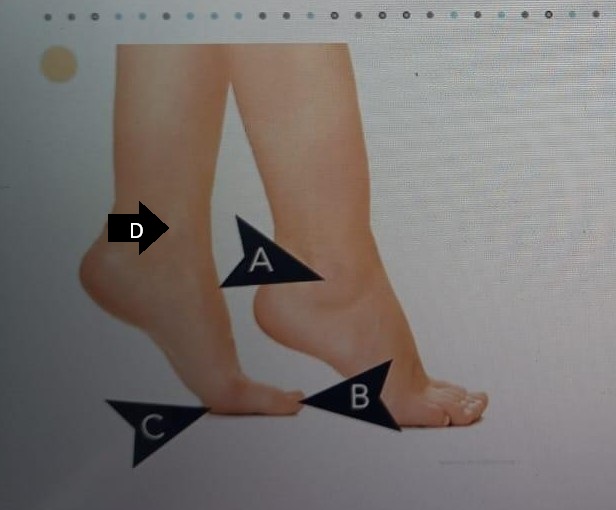A nurse is caring for a client who has chronic venous insufficiency. Which of the following areas should the nurse assess for the presence of a venous ulcer?

A
B
C
D
The Correct Answer is D
Rationale:
A. This area is the lateral side of the the heel and is more commonly affected by arterial ulcers or pressure injuries. It is not the typical location for ulcers caused by venous insufficiency.
B. This area is the area on the tip of toes and is not a typical site for venous ulcers. Ulcers in this location are commonly arterial or diabetic ulcers.
C. This area is the area on the sole of the feet at the base of the big toe and is not a typical site for venous ulcers.
D. This area is the medial malleolus, just above the inner ankle, which is the most common site for venous ulcers. Chronic venous insufficiency leads to venous stasis and increased pressure in this region, causing skin breakdown and ulceration.
Nursing Test Bank
Naxlex Comprehensive Predictor Exams
Related Questions
Correct Answer is B
Explanation
Rationale:
A. First-degree heart block: This rhythm shows a prolonged PR interval but maintains regular P waves before every QRS complex and a consistent rhythm. The presence of P waves and regularity rule out this option.
B. Atrial fibrillation: Atrial fibrillation is characterized by an irregularly irregular rhythm and absent or indistinct P waves due to disorganized atrial electrical activity. A heart rate of 98/min with no clear P waves fits the criteria for this dysrhythmia.
C. Complete heart block: Complete (third-degree) heart block features a complete dissociation between atrial and ventricular activity, with P waves and QRS complexes occurring independently. It typically presents with a bradycardic rhythm, not near 98/min.
D. Ventricular tachycardia: Ventricular tachycardia presents with a rapid, regular rhythm and wide QRS complexes. It usually lacks P waves but is typically much faster than 98/min, often ranging from 140 to 200 beats/min.
Correct Answer is ["B","C","D","E","F","G"]
Explanation
Rationale:
- Temperature 37° C (98.6° F): The client's temperature has remained stable at 37° C from Day 1 to Day 3. Although it is within normal range, the lack of change means it does not reflect any clinical improvement or deterioration in condition.
- Blood pressure 112/56 mm Hg: The systolic blood pressure has improved from 92 mm Hg to 112 mm Hg, suggesting improved perfusion. Although diastolic pressure is unchanged, this rise indicates partial stabilization of cardiovascular status after initial hypotension.
- Heart rate 88/min: The heart rate decreased from 118/min on Day 1 to 88/min on Day 3, indicating reduced sympathetic response. This suggests that blood volume and hemodynamic status have improved, likely due to effective intervention for blood loss.
- Respiratory rate 20/min: A drop from 24/min to 20/min reflects improvement in respiratory effort. The normalization of respiratory rate indicates reduced metabolic demand and improved oxygen delivery after stabilization.
- Oxygen saturation 95% on room air: The client’s oxygen saturation improved from 92% to 95%, returning to normal range. This shows better oxygenation, likely related to improved circulatory status and reduced bleeding or hypovolemia.
- Hemoglobin 15 g/dL: Hemoglobin increased from 7 g/dL to 15 g/dL, returning to normal. This significant rise indicates successful treatment of anemia, likely through blood transfusion, and improved oxygen-carrying capacity.
- Hematocrit 45%: Hematocrit rose from 24% to 45%, matching the hemoglobin improvement. This suggests the client’s volume status and red blood cell concentration have normalized, reflecting effective management of acute blood loss.
- Platelets 100,000/mm³: The platelet count decreased from 120,000/mm³ to 100,000/mm³, remaining below the normal range. This decline may reflect worsening liver dysfunction or ongoing coagulopathy, and does not indicate clinical improvement.
- Albumin 3.0 g/dL: Albumin remained unchanged at 3.0 g/dL and is below the normal range of 3.5–5 g/dL. This reflects persistent impaired liver synthetic function and ongoing risk for complications like ascites and delayed healing.
- Ammonia 160 mcg/dL: Ammonia levels increased from 150 to 160 mcg/dL, indicating worsening hepatic detoxification. This elevated level increases the client’s risk for hepatic encephalopathy and does not signify recovery.
Whether you are a student looking to ace your exams or a practicing nurse seeking to enhance your expertise , our nursing education contents will empower you with the confidence and competence to make a difference in the lives of patients and become a respected leader in the healthcare field.
Visit Naxlex, invest in your future and unlock endless possibilities with our unparalleled nursing education contents today
Report Wrong Answer on the Current Question
Do you disagree with the answer? If yes, what is your expected answer? Explain.
Kindly be descriptive with the issue you are facing.
